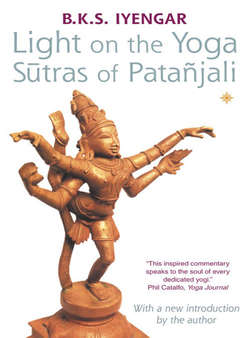Читать книгу Light on the Yoga Sutras of Patanjali - Литагент HarperCollins USD - Страница 8
Patañjali
ОглавлениеFirst I would like to tell you something about Patañjali, who he was and what was his lineage. Historically, Patañjali may have lived some time between 500 and 200 B.C., but much of what we know of the master of yoga is drawn from legends. He is referred to as a svayambhu, an evolved soul incarnated of his own will to help humanity. He assumed human form, experienced our sorrows and joys, and learned to transcend them. In the Yoga Sutras he described the ways of overcoming the afflictions of the body and the fluctuations of the mind: the obstacles to spiritual development.
Patañjali’s words are direct, original and traditionally held to be of divine provenance. After more than twenty centuries they remain fresh, fascinating and all-absorbing, and will remain so for centuries to come.
Patañjali’s 196 aphorisms or sutras cover all aspects of life, beginning with a prescribed code of conduct and ending with man’s vision of his true Self. Each word of the sutras is concise and precise. As individual drops of rain contribute towards the formation of a lake, so each word contained in the sutras conveys a wealth of thought and experience, and is indispensable to the whole.
Patañjali chose to write on three subjects, grammar, medicine and yoga. The Yoga Sutras, his culminating work, is his distillation of human knowledge. Like pearls on a thread, the Yoga Sutras form a precious necklace, a diadem of illuminative wisdom. To comprehend their message and put it into practice is to transform oneself into a highly cultured and civilized person, a rare and worthy human being.
Though I have practised and worked in the field of yoga for more than fifty years, I may have to practice for several more lifetimes to reach perfection in the subject. Therefore, the explanation of the most abstruse sutras lies yet beyond my power.
It is said that once Lord Visnu was seated on Adisesa, Lord of serpents, His couch, watching the enchanting dance of Lord siva. Lord Visnu was so totally absorbed in the dance movements of Lord siva that His body began to vibrate to their rhythm. This vibration made Him heavier and heavier, causing Adisesa to feel so uncomfortable that he was gasping for breath and was on the point of collapse. The moment the dance came to an end, Lord Visnu’s body became light again. Adisesa was amazed and asked his master the cause of these stupendous changes. The Lord explained that the grace, beauty, majesty and grandeur of Lord siva’s dance had created corresponding vibrations in His own body, making it heavy. Marvelling at this, Adisesa professed a desire to learn to dance so as to exalt his Lord. Visnu became thoughtful, and predicted that soon Lord siva would grace Adisesa to write a commentary on grammar, and that he would then also be able to devote himself to perfection in the art of dance. Adisesa was over-joyed by these words and looked forward to the descent of Lord siva’s grace.
Adisesa then began to meditate to ascertain who would be his mother on earth. In meditation, he had the vision of a yogini by the name of Gonika who was praying for a worthy son to whom she could impart her knowledge and wisdom. He at once realized that she would be a worthy mother for him, and awaited an auspicious moment to become her son.
Gonika, thinking that her earthly life was approaching its end, had not found a worthy son for whom she had been searching. Now, as a last resort, she looked to the Sun God, the living witness of God on earth and prayed to Him to fulfil her desire. She took a handful of water as a final oblation to Him, closed her eyes and meditated on the Sun. As she was about to offer the water, she opened her eyes and looked at her palms. To her surprise, she saw a tiny snake moving in her palms who soon took on a human form. This tiny male human being prostrated to Gonika and asked her to accept him as her son. This she did and named him Patañjali.
Pata means falling or fallen and añjali is an oblation. Añjali also means ‘hands folded in prayer’. Gonika’s prayer with folded hands thus bears the name Patañjali. Patañjali, the incarnation of Adisesa, Lord Visnu’s bearer, became not only the celebrated author of the Yoga Sutras but also of treatises on Ayurveda and grammar.
He undertook the work at Lord siva’s command. The Mahabhasya, his great grammar, a classical work for the cultivation of correct language, was followed by his book on Ayurveda, the science of life and health. His final work on yoga was directed towards man’s mental and spiritual evolution. All classical dancers in India pay their homage to Patañjali as a great dancer.
Together, Patañjali’s three works deal with man’s development as a whole, in thought, speech and action. His treatise on yoga is called yoga darsana. Darsana means ‘vision of the soul’ and also ‘mirror’. The effect of yoga is to reflect the thoughts and actions of the aspirant as in a mirror. The practitioner observes the reflections of his thoughts, mind, consciousness and actions, and corrects himself. This process guides him towards the observation of his inner self.
Patañjali’s works are followed by yogis to this day in their effort to develop a refined language, a cultured body and a civilized mind.
